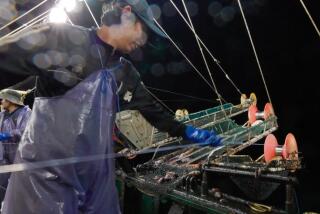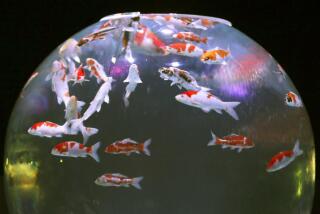Tangled in Drift Nets
- Share via
Less than three months remain for Taiwan, Korea and Japan to accept monitoring and regulation of their high seas drift-net fisheries. They should understand by now the seriousness which the United States attaches to the issue and its readiness to apply sanctions if necesary.
The precise impact of drift nets is not known, which is why the negotiations are focused on establishing the facts by placement of American observers aboard the fishing boats. Only in that way can the dimensions of the problem be measured accurately. There is, nevertheless, enough evidence of the negative impact of the drift nets to give urgency to the search for controls. Earthtrust, a marine conservation organization based in Honolulu, sent its own observation vessel to watch operations last September and concluded that drift nets are tantamount to “strip mining the ocean.” The practice threatens the whole balance of marine life in the Pacific, according to Donald White, executive director of Earthtrust. The National Marine Fisheries Service, which is coordinating drift-net research, is reserving judgment while expressing concern. The careful observation of Japanese drift-net operations in Alaskan waters, before court action barred the operations in 1987, demonstrated the incidental kill of mammals. Some scientists already have concluded that the nets are killing beyond sustainable limits.
Jim Coe, coordinating research for the NMFS from Seattle, estimates that 1,000 to 1,500 vessels are now engaged in various drift-net operations seeking squid, tuna and marlin, and salmon in unprotected international waters of the Pacific. Each vessel sets from 18 to 33 miles of net each night. The nets float on the surface, hanging 30 feet down, the 4-inch nylon filament mesh capturing almost everything that runs against the net, including marine mammals such as dolphins and seals, as well as birds and non-targeted fish. The nets are so inefficient, however, that an estimated half of the catch is wasted, killed but lost overboard as the net is brought aboard the vessel. “Short of dynamite fishing, it is the most destructive form of fishing,” according to White of Earthtrust.
The surface deployment of the nets is posing a serious problem in the South Pacific for American albacore fishermen who pioneered fishing in the area some 600 miles south of Pitcairn Island. They now find their boats surrounded from time to time by miles of drifting nets set by the Taiwanese, Japanese and Korean vessels, according to Bill Perkins, general manager of the Western Fishboat Owners’ Assn.
Negotiations for monitoring and enforcement have been under way since Congress adopted the Drift Net Impact Monitoring Assessment and Control Act at the end of 1987. There has been resistance, however, from Taiwan, Korea and Japan, the three nations that pursue drift-net fishing. So far, only brief observation missions have been permitted. That resistance raises serious questions about the willingness of the three nations to negotiate a workable agreement. It raises questions about their commitment to protecting at sustainable levels resources which are as important to them as to the United States. And it raises suspicions that they may be trying to hide violations of the international agreement that already protects salmon of U.S. origin.
Yet another round of negotiations with Japan will begin Monday. No further talks with Korea and Taiwan are planned at the moment. The deadline for agreement is June 29. If there is no agreement on that date, the Department of Commerce is required to impose sanctions which only President Bush could decline to implement. Now is a good time for both Commerce and the White House to make sure that Taipei, Seoul and Tokyo appreciate Washington’s determination.
More to Read
Sign up for Essential California
The most important California stories and recommendations in your inbox every morning.
You may occasionally receive promotional content from the Los Angeles Times.













